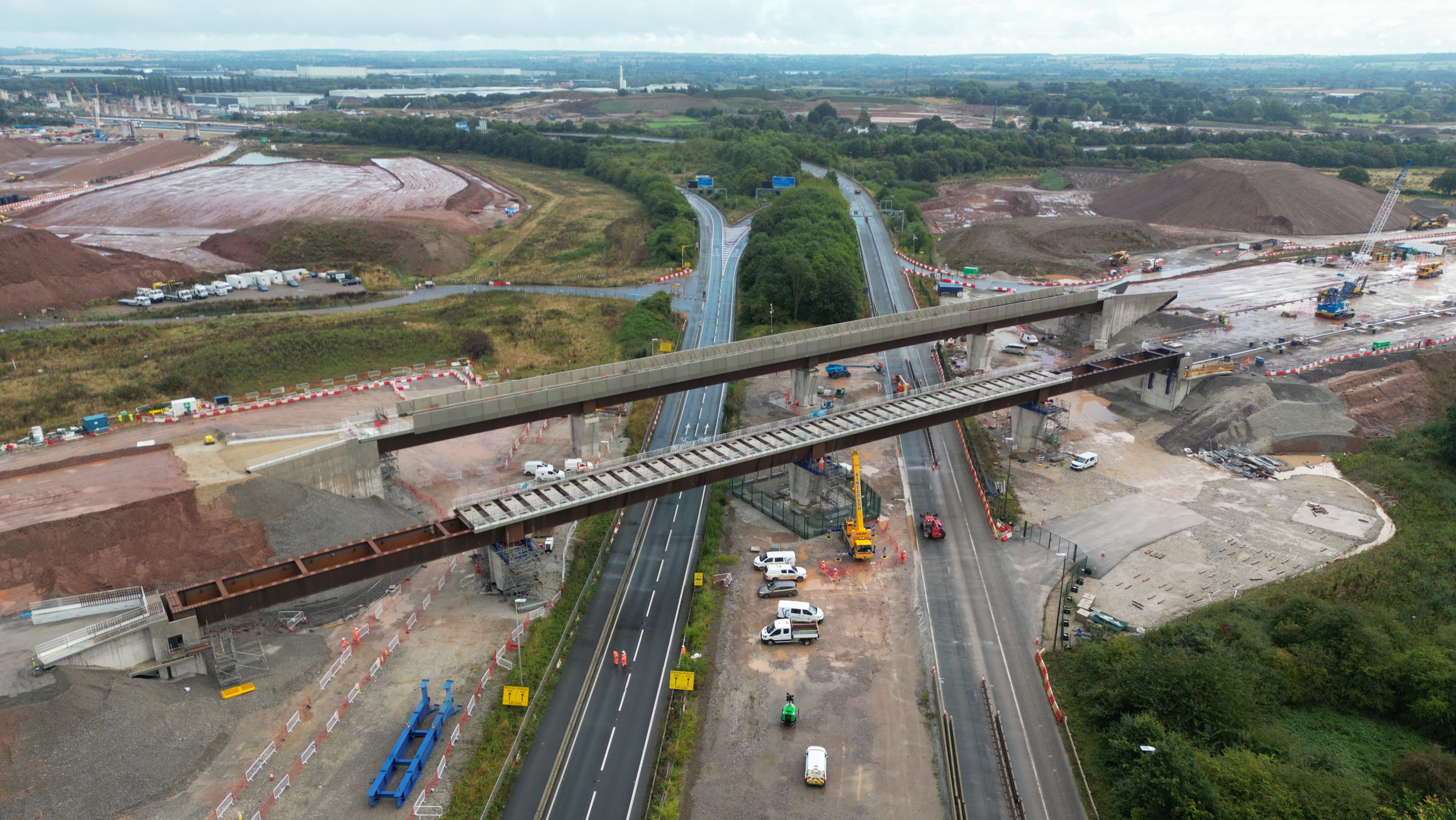- Impressive weekend operation marks the completion of four ‘pushes’ to move two parallel viaducts into place over the M42/M6 link roads
- The fourth ‘push’ saw the 1,100 tonne West Link Viaduct in North Warwickshire moved in just 11 hours next to the parallel East Link Viaduct
Balfour Beatty VINCI have completed the final operation to move two railway viaducts for HS2 into place over the M42/M6 link roads in North Warwickshire, making them the first viaduct structures to be built at Delta Junction.
The ‘push’ to move the 158-metre-long ‘West Link Viaduct’ into its final position over both westbound and eastbound motorway link roads took a total of 11 hours over the weekend.
Balfour Beatty VINCI and National Highways collaborated to minimise disruption for people using the roads and enabling these engineering feats to take place. Last weekend’s operation was completed quicker than planned, allowing the motorway link roads to be reopened 6.5 hours ahead of schedule.
The viaducts are part of a group of 13 viaducts which make up HS2’s triangular Delta Junction. This section of the railway enables high speed trains to travel between London, Interchange Station in Solihull and Birmingham Curzon Street Station.
In June, the first 84 metre section of the composite viaduct was moved to its halfway position. Since then, three further steel girders were welded to the back of the first section and 38 precast concrete slabs were installed to complete the 158-metre-long structure, which has now been moved over both link roads.
The parallel ‘East Link Viaduct’ was moved into place using an identical two-stage process during two weekend operations in February and April this year. This viaduct is currently being prepared to be brought into use as an internal haul road by the end of December, to move material from Bromford Tunnel to the Delta Junction, taking thousands of lorries off the local road network.
The four operations were delivered by a team of 25 people from specialist steelwork company Victor Buyck Steel Construction (VBSC), working on behalf of Balfour Beatty VINCI, using a push-pull jacking system which gives greater flexibility during the launch operation.
HS2’s high-speed trains will operate on reliable new infrastructure between London and Birmingham, significantly reducing journey times and freeing up space on the existing mainline for more local and freight services. The railway is expected to be operational between 2029 and 2033.
JoseLuis Preciados, Senior Project Manager at Balfour Beatty VINCI said: "This final viaduct push is a significant milestone in our construction of HS2’s Delta Junction. I’m incredibly proud of the BBV team, who’ve worked tirelessly throughout this year to ensure each of these complex operations were planned and delivered with precision.
“Each viaduct deck was built offline and moved into position over a weekend closure of the highway, drastically reducing the impacts on road users. We’ve worked in collaboration with our partners National Highways throughout the entire process, to make sure that this activity was delivered safely and efficiently.”
Panos Psathas, Senior Project Manager at HS2 Ltd said: “Completing the last in a quartet of viaduct pushes this year is an impressive achievement for the team, particularly as these are the first huge viaduct spans to be built in the Delta Junction.
“We’re now at peak construction, with thousands of specialist engineers, architects, designers and project managers working together, using cutting edge technology like this to deliver Britain’s new high-speed railway.”
Tibo Suvée, Project Manager at Victor Buyck Steel Construction said: “This has been a complex eight-month operation, and the first time our push-pull jacking system has been used in the UK.
“The technique provides greater flexibility during the launching operation by allowing the bridge to be moved backwards or both ways if needed.”
National Highways Network Planner, David Patmore, said: “Complex operations such as this will inevitably cause some disruption but we have worked extremely hard, with HS2 and their partners, to minimise that disruption for people using our roads.
“We’d like to thank motorists for their patience while these significant works have been successfully and safely completed.”
The Delta Junction is made up of embankments, cuttings and a total of 13 viaducts taking high speed tracks over motorways, local roads, existing rail lines, rivers and floodplains. The viaducts include 6 precast segmental viaducts, 4 composite viaducts and 3 low viaducts.
The layout of the Delta Junction triangle means the railway from London curves west on a spur towards Birmingham Curzon Street Station. As trains come out of Birmingham, the line heads north to meet the main HS2 line, which will then connect to the West Coast Main Line to Manchester. The third side of the triangle allows trains to run between London and Manchester without stopping at Birmingham.
ENDS
All non-media related enquiries should be directed to +44 (0)20 7216 6800 or info@balfourbeatty.com
Notes to editors:
- Balfour Beatty is a leading international infrastructure group with 26,000 employees driving the delivery of powerful new solutions, shaping thinking, creating skylines and inspiring a new generation of talent to be the change-makers of tomorrow.
- We finance, develop, build, maintain and operate the increasingly complex and critical infrastructure that supports national economies and deliver projects at the heart of local communities.
- Over the last 114 years we have created iconic buildings and infrastructure all over the world. Currently, we are working to deliver Hinkley Point C, the first UK nuclear power station in a generation; constructing the world-class arts and cultural facility, the Lyric Theatre, in Hong Kong; and designing, building, financing, operating and maintaining the Automated People Mover superstructure at the fifth busiest airport in the world, Los Angeles International Airport.

Image: The 1,100 tonne West Link Viaduct moved next to the parallel East Link Viaduct
